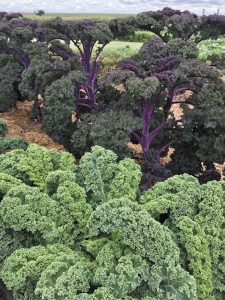September 1, 2020
Fall Gardening Offers Opportunities for Late-Season Vegetables
By Ruth Litchfield, Sarah Francis, Cynthia Haynes
Iowa State University Extension
After last week’s derecho storm damaging many gardens, now may be a good time to begin planning a fall garden. Late summer is a good time to start a fall garden of lettuce, kale, carrots, radish and beets. Many of these vegetables can be sown directly in the garden and harvested within 60 days or less. Watch the latest quickinar video from ISU Extension and Outreach to learn more.
Vegetables are packed full of fiber, vitamins A and C, potassium, magnesium and other minerals, various antioxidants and phytochemicals. Despite the popular “fresh is best” message, all types of vegetables, fresh, frozen, or canned are nutrient rich and a part of a healthy meal plan. The color of the vegetables is equally important as the pigment contain antioxidants.

Try to eat a variety of colorful vegetables. Here are a few of the benefits colorful vegetables offer:
Deep red vegetables: red cabbage, beets, kidney beans, red peppers, red potatoes and radishes are colored by natural plant pigments called “lycopene” or “anthocyanins.”
Lycopene may help reduce the risk of several cancers, especially prostate cancer.
Anthocyanins are powerful antioxidants that protect cells from damage, and are linked with keeping the heart healthy.
Deep yellow or orange vegetables: pumpkin, sweet potatoes, butternut-yellow summer or winter squash, carrots, yellow peppers and yellow tomatoes are colored by natural plant pigments called “carotenoids.”
Carotenoid-rich foods help maintain healthy eyes and can help reduce the risk of cancer and heart disease, and improve immune system function.
Deep green vegetables: artichokes, avocados, green beans, cucumbers, green onions, green pepper, green cabbage, broccoli, asparagus, romaine lettuce, spinach, bok choy and Brussel sprouts contain the phytochemicals – indoles, lutein and zeaxanthin.
Indoles may protect against breast and prostate cancers; found in cruciferous vegetables like broccoli, cabbage, bok choy and Brussel sprouts. Lutein and zeaxanthin may help reduce risk for cataracts, age-related degeneration and chronic inflammation; found in kale, peas, spinach.
Deep blue and purple vegetables: eggplant is colored by plant pigments called “anthocyanins.”
Anthocyanins are powerful antioxidants that protect cells from damage, and are linked with keeping the heart healthy.
White vegetables: mushrooms, scallions, leeks, onions, cauliflower, garlic, jicama, parsnips, turnips and ginger are colored by pigments called “anthoxanthins.”
Anthoxanthins help maintain healthy cholesterol and blood pressure levels, and may reduce the risk of stomach cancer and heart disease.
Many vegetables are good sources of vitamins A (orange and yellow vegetables), K (dark green leafy vegetables) and E (green leafy vegetables). To increase the absorption of these vitamins it’s beneficial to enjoy these vegetables with a little fat.
For those interested in learning more about gardening, contact your county extension office for information about the Master Gardener program at ISU Extension and Outreach. Training begins across the state this fall.
All Sow, Grow, Eat and Keep weekly quickinars are available online. The topics talk about gardening, food preparation, and food preservation. Send your food or garden questions to sowgroweatkeep@iastate.edu.
Source: 2018 State Indicator Report on Fruits and Vegetables (CDC)
About the Authors:
Ruth Litchfield, Food Science and Human Nutrition, 515-294-9484, litch@iastate.edu
Sarah Francis, Food Science and Human Nutrition,
515-294-1456, slfranci@iastate.edu
Cynthia Haynes, Associate Professor in Horticulture
515-294-4006, chaynes@iastate.edu
Filed Under: Community
Trackback URL: https://www.50pluslife.com/2020/09/01/fall-gardening-offers-opportunities-for-late-season-vegetables/trackback/


